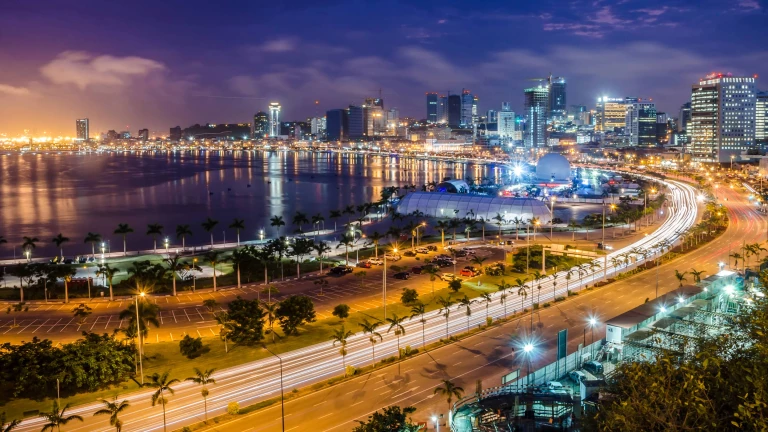Africa is setting its sights on a future shaped by a young population, rapid urbanization, climate change, growing digital capacity, regional cooperation, and entrepreneurial innovation.
Picture the world’s children in 2050. Where do they come from? The answer might surprise you. If today’s demographic trends continue, almost half of all people under 18—about 40%—will have been born and raised in Africa. As digital penetration increases, a growing number will be adept users of technology, and some will be part of a new generation of world-class innovators in Africa. Most of this population will grow up in cities, often in urban areas that doubled in size during their childhood. Regardless of where they live, many may be desperately affected by the consequences of climate change.
Moreover, as these young Africans grow up, they will become an enormous consumer market and a large share of the global workforce. As a group, they could become influential in the growth of international business and the evolution of emerging markets. So far, however, none of the stakeholder institutions that will be involved in their lives—businesses, governments, civil society organizations, and development agencies—are fully prepared for the opportunities and challenges created by this new demographic.
Why Africa’s Future Matters
The ongoing African baby boom is just one of six broad megatrends that are already beginning to affect the continent. Others include the accelerating urbanization of the region into megacities, the expansion of internet and digital penetration, and the increasing effects of climate change. Two other factors that will shape Africa’s future are a growing movement toward international cooperation within the continent and the rise of local innovation, including many advances led by women and young entrepreneurs.
To better understand these megatrends—and to suggest game-changing moves that might help the continent reach its remarkable potential—we conducted an in-depth strategic analysis of prospects for Africa over the next 30 years. More than 120 experts from a wide range of backgrounds participated in interviews, workshops, and focus groups. These advisors included African political and business leaders, including executives of leading firms across sectors; influential figures in civil society, academia, and key not-for-profit organizations; thought leaders on African economics, society, and development; and leaders from US government agencies working in Africa (including the project sponsor, USAID).
Unlocking the power of Africa’s people is fundamental to achieving a brighter future for its citizens — and to advancing global economic growth and development.
The mood in most of these conversations reflected a mix of excitement and concern. Unlocking the power of Africa’s people is a daunting task—but doing so will be fundamental to achieving a brighter future for African citizens, and for economic growth and development in the rest of the world as well.
The Six Megatrends
Here is a closer look at the most significant megatrends forging the Africa of the mid-21st century.
Africa’s people will be young.
By 2050, the population of the continent, including sub-Saharan and North Africa, will double to reach 2.5 billion. As much as 60% of Africa’s people will be under 25. A huge working-age population can be a disruptive force, leading to unrest and migration if there are insufficient jobs. But with ample opportunity, the youthful demographics can help catalyze economic growth, particularly in domains that require motivated and skilled labor, such as manufacturing, energy (especially the transition to green sources), and digital technology.
With its young population and an estimated combined GDP of $2.96 trillion in 2022, Africa is poised to become the world’s largest growth market for consumer goods and services. It may also serve as a primary resource for talent, exporting digital natives and skilled labor to the rest of the world. These bright futures can only come to pass, however, if the region’s educational institutions, supported by government and private investment, can provide the necessary schooling, skills training, and related services—a task that could require as many as 17 million additional professional educators. “If Africa is to create jobs for the youth bulge,” says Corporate Council on Africa CEO Florie Liser, “[its countries will] need to harness their capability to add value, to become bigger players in regional and global supply chains, and thereby impact their development.”
Africa’s cities will be crowded.
Urban areas in Africa will attract an additional 1 billion residents by 2050. Experts forecast the urban population to triple and the number of “megacities” —densely settled areas with 10 million or more residents—to increase from three (currently Cairo, Kinshasa, and Lagos) to 14. The growth of African cities will add vibrancy to the economy and culture of the region, attracting significant foreign investment and strengthening global business and trade ties.
When urbanization occurs this abruptly, it can destabilize a region; it can be challenging to provide basic services such as electric power and education, along with transportation links. However, if investment in infrastructure can occur rapidly enough, then urbanization tends to accelerate GDP and consumer spending, facilitate entrepreneurship and innovation, create new markets, and increase worker productivity. It can also lead to greater interchange between the government, the private sector, and the employee base. “Without that dialogue,” says Yvonne Tsikata, former World Bank Vice President and Corporate Secretary, “we will not succeed in achieving our development goals.”
The continent will be vulnerable to climate change.
Despite contributing less than 4% to global greenhouse gas (GHG) emissions, 35 of the 50 countries most at risk from climate change effects are located in Africa. The continent can expect a temperature increase that will occur 1.5 times faster than the global average increase. This will lead to total deglaciation of Africa’s mountainous areas by 2050, rising sea levels along the coasts, and more extreme weather events, including droughts, storms, floods, and excessive heat and cold. These changes will have catastrophic impact on biodiversity and animal habitats—especially worrying because Africa is home to 25% of the world’s remaining rainforests. Climate change will also adversely affect some African livelihoods, such as farming and energy-related jobs, which are vulnerable to weather-related conditions. It may also intensify the threat from viruses and other health risks.
To mitigate these effects, the continent’s leaders will have to address current gaps in the availability of climate-related data. “We need to think about how to get accurate information to people on the ground in a timely manner,” says Joanne Yawitch, CEO of the National Business Initiative in South Africa, “and educate people on how to act on the data.” Many experts believe that climate-related challenges could drive Africa to become a center of innovation, leading the development of solutions. Among the possibilities, which could add up to a $320 billion industrial sector in Africa, are renewable energy (building on the region’s abundance of solar, wind, and geothermal resources and its experience with off-the-grid solar solutions), carbon sequestration (taking advantage of Africa’s lands, forests, and coastlines), and new approaches to sustainable land use and agriculture. All of these are potential vehicles for green job creation.
Africa will move quickly into digital technology.
This will occur more rapidly than many people currently expect. Africa’s digital tech sector, including software, cloud, and internet services, has experienced tremendous growth since 2010. Currently, its five-year growth rate is at 47%. Internet penetration has grown tenfold in the past 12 years, and the internet economy will reach $712 billion by 2050. There are more than 600 active digital and technological hubs across the continent, all making notable advances in fostering innovation and with both home-grown and global companies participating. The largest clusters of digital activity are in Egypt, Kenya, Nigeria, and South Africa—with Ghana, Morocco, and Tunisia close behind.
With appropriate investments in infrastructure, upskilling, and education, Africa’s immense working-age population could position the continent as a leader in digital services.
“We’ve seen some exciting green shoots of growing digital capacity on the continent, but there’s more work to be done,” says Nitin Gajria, Managing Director, Google Sub-Saharan Africa. “The key pillars to advancing Africa’s digital growth are increasing connectivity; investing in entrepreneurs; creating affordable, fit-for-context products; and supporting civil society in doing these.” With appropriate investments in infrastructure, upskilling, and education at a large scale, Africa’s immense working-age population could position it as one of the world’s leaders in digital services.
The region will be more open to intracontinental cooperation.
The COVID-19 pandemic and subsequent food crisis have demonstrated to African decision-makers in the public and private sectors that the continent needs to become more self-sufficient. Its countries and businesses need to cooperate more and reduce their reliance on international support. A few initiatives have begun to move Africa in this direction.
For example, in 2018, 44 of the 55 African countries signed the African Continental Free Trade Area agreement (AfCFTA), establishing the world’s largest such trade bloc in terms of population and land area, covering 1.3 billion people. As of 2021, it has been signed by 54 member states and is gradually advancing to becoming operational. If the pact can overcome complex hurdles of the past—such as logistics, visas, and existing barriers to trade—it could produce substantial positive economic value. “The AfCFTA is very promising. Its potential impact in fighting key continental challenges such as food insecurity is huge,” comments former Senior Vice President of the African Development Bank Charles Boamah. “The political will that enabled this landmark agreement needs to be sustained to assure effective implementation and full realization of the promise.”
Another indicator of support for intracontinental cooperation was the African Union’s adoption in 2015 of Agenda 2063, a blueprint for future projects such as high-speed rail systems. There is also more interest in strengthening continental and regional organizations such as the AU, Southern African Development Community, and the Economic Community of West African States.
Africa will be a more active source of innovation and entrepreneurship.
About 22% of working-age Africans start small businesses, as compared to 18% in Latin America and 13% in Asia. The continent has a history of breakthrough innovation in recent years, including mobile payment and digital health care platforms. The continent’s entrepreneurial culture is especially promising from the standpoint of gender parity. Women from Africa are twice as likely to start an enterprise as women in other geographies. This rise in innovation is supported by the continent’s digital hubs, but is not limited to information and communications technology. Entrepreneurship in Africa is beginning to fuel transformative change in sectors such as energy, health services, pharmaceuticals, and sustainable agriculture and land use. In fact, the agricultural sector could grow to as much as $320 billion per year in annual revenues by 2030, helping to solve the challenges of food shortages related to climate change. Africa could even evolve into a breadbasket for Europe and the Middle East.
Meeting the Opportunities and Challenges
If these megatrends can be navigated successfully, they could help in advancing Africa’s social and economic progress. The world has seen many emerging economies parlay their young populations and entrepreneurial spirit into innovative growth. With targeted investment and thoughtful action, the same could be true for Africa.
One critical enabler to African innovation should be the expansion and availability of funding sources, including venture capital and private equity. “There are many bright innovators on the continent who have incredible ideas, but can’t monetize them due to an inability to access capital,” says Nicholas Nesbitt, chairman of the Kenya Private Sector Alliance. “Creating new channels for investments will be key to supporting African innovation.”
If you would like to learn more about significant trends and promising policy developments in Africa, see the full report here. The report also details two game-changing concepts with the strongest potential to drive African development over the next decade: digital skills acceleration and climate analytics and planning. This research was funded by the USAID Mission to the African Union and conducted by Boston Consulting Group (BCG).






